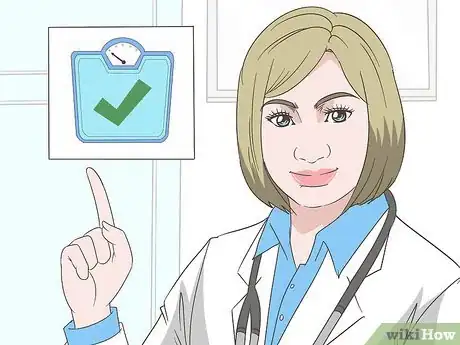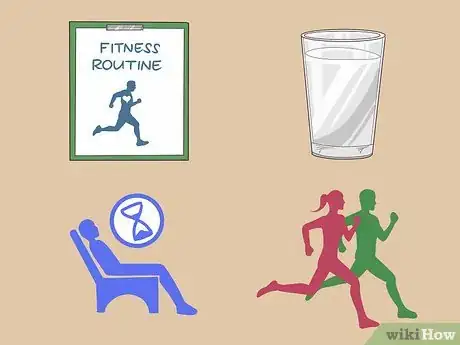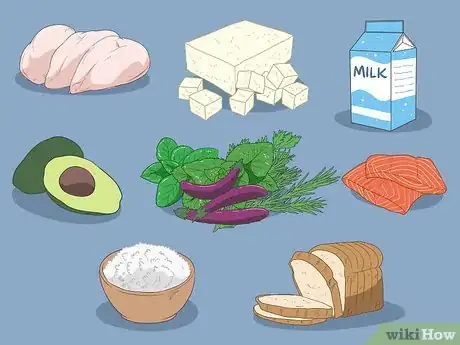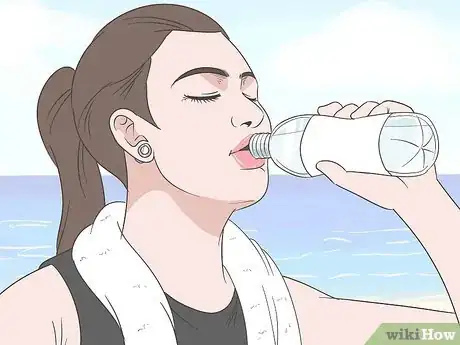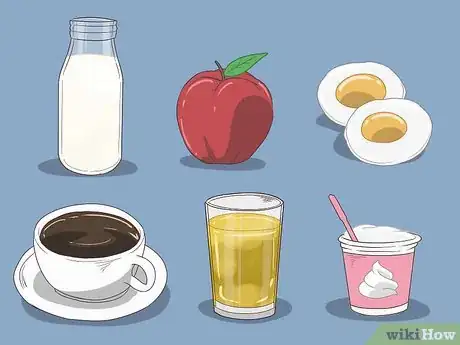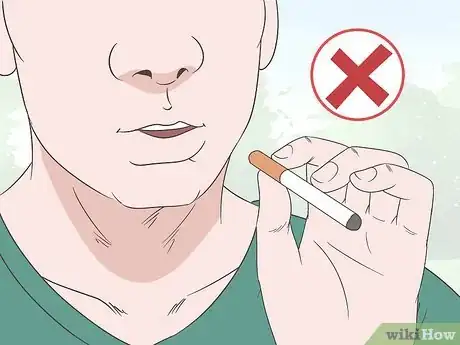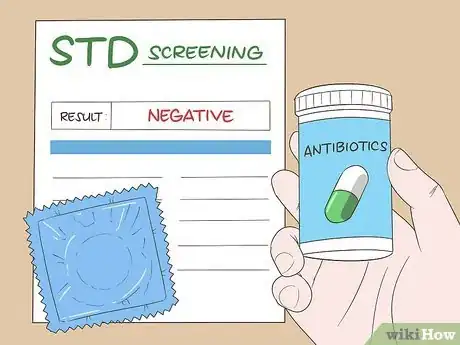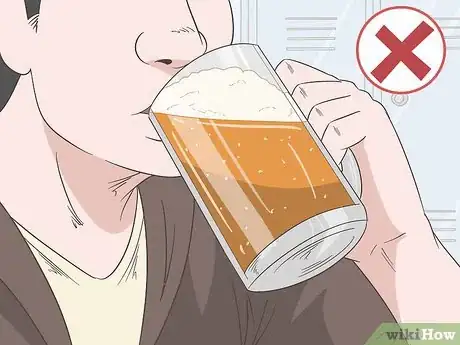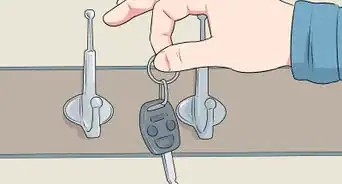This article was medically reviewed by Luba Lee, FNP-BC, MS. Luba Lee, FNP-BC is a Board-Certified Family Nurse Practitioner (FNP) and educator in Tennessee with over a decade of clinical experience. Luba has certifications in Pediatric Advanced Life Support (PALS), Emergency Medicine, Advanced Cardiac Life Support (ACLS), Team Building, and Critical Care Nursing. She received her Master of Science in Nursing (MSN) from the University of Tennessee in 2006.
There are 16 references cited in this article, which can be found at the bottom of the page.
wikiHow marks an article as reader-approved once it receives enough positive feedback. In this case, 91% of readers who voted found the article helpful, earning it our reader-approved status.
This article has been viewed 277,442 times.
Becoming healthy is a process that involves time, commitment, and a willingness to change. However, with some dedication you can start building habits you can feel good about.
Steps
Establishing a Fitness Routine
-
1Exercise every day. Exercising your body through formal fitness routines or simply through being more active throughout the day is beneficial to your health. Regular exercise is one of the most important steps toward a healthy body and mind, with innumerable benefits such as a decreased risk of Alzheimer’s,type 2 diabetes, and some types of cancers.[1]
- You should strive for some form of physical activity each day. You don't necessarily have to hit the gym seven days a week. Simply look for opportunities to be active at least 20 or 30 minutes each day, such as parking father away or choosing to walk somewhere instead of driving, taking the stairs instead of the elevator, taking your dog for long walks, etc. You will still get a lot of health benefits through daily moderate exercise.[2]
- Choose an activity that's convenient and that you enjoy. If you love long walks, take your dog for a brisk 30 minute walk each night. If you love biking, consider biking to work each day instead of driving. Try aerobic classes, Zumba, pilates, or high-intensity training.
-
2Reach your ideal weight. Carrying too much or too little body fat can affect our health in many ways. Being underweight is also not ideal for your health. It's important to find a comfortable and healthy balance for your frame and height. Speak with your doctor for guidance as to where you fall on that spectrum.
- One tool that can determine if you need to gain or lose weight by discovering your BMI. This is a calculation based on your height and weight and you can use a BMI calculator online to figure out if you need to gain or lose. Your BMI should be between 18.5 and 24.9. Anything lower than 18.5 is considered underweight. Anything higher than 24.9 is considered overweight. A BMI over 30 is considered obese.[3] Be aware that BMI is not always an accurate indicator (if you are very short and very muscular, for instance, your BMI may be skewed), so make sure you also talk with your doctor.
- If you are overweight or underweight, talk to your doctor about a weight loss or weight gain plan. You gain or lose weight by eating more or less calories than you consume each day. Food labels and online nutrition calculators can help you assess the amount of calories in your food. You can also use online calculators to estimate how many calories a given activity burns for you considering your height and weight.
- While being overweight or underweight is not healthy for your body, it is also unhealthy to make very sudden or drastic changes to your diet. Remember that weight gain and loss both require a slow, gradual, and consistent change to your diet and exercise routine in order to be safe and healthy for you.
-
3Exercise all of your muscle groups. Many people prefer to focus exclusively on either cardio health (running, biking, etc.) or weight training. However, a truly healthy body needs to exercise both sets of muscles.[4]
- Not only does doing several different activities work all your muscles (which can help prevent injury), it also keeps you from getting bored. Include aerobic and strength training workouts in your routine.
- Aim for 150 minutes of moderate aerobic activity or 75 minutes of vigorous activity weekly. Moderate aerobic activity would include things like walking or light cycling. Vigorous activity would include things like jogging, running, and intense cycling.
- You should incorporate strength training twice a week. Strength training can come in the form of lifting weights or engaging in activities like Pilates, which forces you to use your body as a weight to strengthen and tone core muscles.[5]
-
4Take precautions when exercising. While exercise is necessary for a healthy body, if you don't follow certain precautions and exercise correctly, you put your body at risk for injuries. Make sure you treat your body with respect when working out.
- Ease into a fitness routine. Do not try to go from a sedentary lifestyle to working out at the gym five days a week. Give yourself small fitness goals, like taking a certain number of steps per day, or running half a mile, then a mile, then two miles.
- Stay hydrated. You should sip water throughout your workouts. Becoming dehydrated can lead to dizziness or headaches during your sweat session.[6]
- Have a rest day between strength training workouts.
- Get a fitness partner. Having someone to walk or jog with or take group fitness classes with at the local gym can be motivational. It can also help by providing you with someone you know that can watch for signs that you are overdoing it.
Eating Healthfully
-
1Evaluate your diet. In the early stages of working toward a healthier lifestyle, you must assess what you are currently eating. If you notice any unhealthy habits, strive to make changes to your diet.
- Keep a food diary. For a week or so, write down every food that you eat. Websites like www.myfitnesspal.com provide free templates for logging foods and keeping track of calories. It's important to know what your areas of strength and weakness are so that you can make improvements where needed.
- Get a rough sense of how many calories you're eating. Women need about 1,800 to 2,000 calories a day. Men need about 2,400 to 2,600. However, these levels are for sedentary adults. If you're more active, you may need to be consuming more calories.[7]
-
2Adopt a healthier diet. After keeping a food log for a week, make adjustment to your diet. You want to make sure you're getting the healthiest foods possible.
- At every meal throughout the day, half of your plate should be plant-based, such as fruit and vegetables, and processed as little as possible. In other words, uncooked fruits and vegetables are ideal.[8]
- Round out your meals and snacks with lean protein like chicken breast or tofu, dairy, and whole grains. Remember that a healthy diet is about variety: your body requires many types of nutrients to function optimally, and eating a bland diet of the same foods every day (even if they are healthy foods) will not provide these nutrients.
- Not all fats are bad for you. Good fats can be found in oily fish like salmon and tuna, avocados, nuts, and olive oil. These are essential to a well-balanced diet and proper brain functioning.
- It may take a few days or even weeks for your body to become accustomed to eating healthy foods. Some foods like caffeine, carbs, alcohol, and sugar are addictive and can cause withdrawal symptoms like headaches or moodiness.
-
3Drink water. Even though our bodies are made mostly of water, most Americans do not consume enough water throughout the day. Drinking more water can help with your overall health and minimize fatigue, hunger pangs, and other symptoms of dehydration.
- It's a common misconception that you should drink eight glasses of water a day. The amount of water each person needs a day varies depending on body size, activity level, and climate. In general, to calculate how much water your body needs at rest in a cool climate, divide your weight in half. A 200 pound person needs about 100 ounces a day when doing things like working at a desk or watching TV.[9] If you're more active, or live in a hotter climate, you may need a bit more than half your body weight.
- Even caffeinated beverages like coffee and tea count toward your total intake of water, but these should not make up the bulk of your fluid intake.[10]
-
4Replace sugary drinks. Soda, juice, or alcoholic beverages are heavy on calories and sugar but low on nutrition. These should be banned from your diet if you want to be healthy.
- If you don't enjoy the taste of plain water, drink decaffeinated tea or add a bit of 100% juice into your water. You can also try creating infused water: make a pitcher of ice water and put in a variety of sliced fresh fruits or even herbs like rosemary or mint. It's essentially a mild herbal tea.
-
5Eat breakfast. Research has shown that people who skip breakfast tend to overeat during the remainder of the day.[11] So, to curb your appetite, don't skip the first meal of the day.
- Many Americans eat a carb-heavy breakfast like donuts, waffles, or cereal, which can be high in calories but low in nutrition. These types of breakfast will not keep you feeling full very long. Instead, opt for protein like eggs or unsweetened yogurt with fruit, and lowfat milk, fresh orange juice, tea, or black coffee (avoid adding sugar and cream). [12]
-
6Eat at regular, planned times. Train your body to expect a specific amount of calories at regularly scheduled meals three times a day. If you find that you feel hungry in the afternoons or mid-mornings, try eating smaller meals more frequently. Avoid mindless eating throughout the day or eating late night snacks.
- Snacking isn't bad for you if you do it right. In fact, grazing throughout the day on healthy snacks like yogurt, nuts, or string cheese can keep you from feeling deprived and overindulging later. Just make sure it's all in moderation and that you keep track of your calorie intake, since it can be easy to overdo it by mistake.[13]
Changing Your Lifestyle
-
1Quit Smoking. Smoking is directly correlated with lung and mouth cancers, heart disease, stroke, and cancers of the throat, pancreas, and bladder. It is impossible to be a truly healthy person who smokes.[14] Seek help to quit if you can't do it on your own.
- Talk to your doctor about quitting smoking. He or she may be able to help you form a treatment program.
- You should seek support when quitting smoking. Ask your friends and family members to support your decision. If you know people who smoke, request that they not do so in front of you. You might also want to consider joining a support group.
-
2Have Safer Sex. Engaging in risky sexual behaviors puts you at risk for unwanted pregnancies as well as sexually-transmitted diseases. Use protection when having sex and avoid sleeping with partners you do not know.
- Latex condoms can greatly reduce the risk of contracting an STD. If you do not know your partner's status, always use a condom during sex. Make sure you check the expiration date and check for tears.
- If you're sexually active and not in a monogamous relationship, get screened for STDs routinely. Make an appointment with your doctor at least every six months for a full panel STD test. If you're uncomfortable going to your regular doctor, there are many free clinics that offer STD screening.
- Many STDs are treatable with antibiotics; however, they can cause serious complications, such as infertility, if left untreated long-term. STDs which are common and treatable are chlamydia, gonorrhea, and syphilis. Some STD that are not curable but one can live with are herpes, HIV, and genital warts.The majority of STDs have no symptoms so the only way to know if something is wrong is getting tested.
-
3Stop binge drinking. Binge drinking has a lot of negative effects on your overall health. You should strive to drink in moderation only. Having more than three drinks in one night is considered heavy drinking. Heavy drinking, especially on a regular basis, can lead to a host of health problems including cancer, heart failure, and stroke. If you do drink, have only a couple of drinks a night.[15]
- Do not feel pressured to drink. Binge drinking is a common past time, especially for young people, but try to remember your health. There are absolutely no health benefits to binge drinking. If you're in a social situation where people are drinking heavily, have something like soda instead of alcohol.[16]
- It is recommended that women stick to one drink or less per day and men have two drinks or less per day.
- If you consume more than a few drinks a week, recognize that you may have a drinking problem and join Alcoholics Anonymous or quit drinking without Alcoholics Anonymous.
-
4Clear your anxious thoughts. Stress and anxiety can take a toll not only on your mental wellbeing. They can also affect your physical health. Learn some strategies to control intrusive, anxious thoughts and to take your mind off of your troubles.
- Confront your anxieties by allowing yourself to think through what is bothering you, determine how much control you have over the situation, and then set aside worries about anything you cannot control.
- Consider practicing meditation to take your mind off your anxieties. Meditation is a conscious way of clearing your thoughts, most often by focusing on your breathing or other physical sensations and not allowing other thoughts to take residence in your mind.
- If you have chronic trouble controlling worrisome thoughts, consider seeing a therapist. You may have an underlying anxiety disorder.
-
5Think positively. By focusing on the positive in given situations, rather than dwelling on the negative or ruminating possible bad scenarios, you can improve your physical health: studies have shown that people who think positively can fight off illness like colds and heart disease better than people who think negatively.[17]
- It can be hard to retrain a lifetime of thinking negative thoughts. Start by focusing on things you are grateful for instead of things that worry you or bother you. Every time you start to think a negative thought — whether its a worry that your boss won't like your report or a mental criticism of another person's appearance — replace that thought with two things you are thankful for in that moment.
Warnings
- Talk to your doctor before incorporating any new fitness or diet regimen.⧼thumbs_response⧽
- For persistent health problems that cannot be addressed with changes to diet and exercise, be sure to see your doctor; it could be a sign of an underlying condition. Never ignore signs or symptoms that worry you.⧼thumbs_response⧽
- Be sure to incorporate new routines gradually to avoid overwhelming your system.⧼thumbs_response⧽
References
- ↑ http://www.cdc.gov/physicalactivity/basics/pa-health/
- ↑ ClevelandClinic.org: Diet, Exercise, Stress and the Immune System
- ↑ http://www.cdc.gov/healthyweight/assessing/index.html
- ↑ http://www.webmd.com/fitness-exercise/features/get-stronger-and-leaner-with-cross-training
- ↑ http://www.mayoclinic.com/health/exercise/AN01713
- ↑ http://www.mayoclinic.com/health/dehydration/DS00561/DSECTION=symptoms
- ↑ http://www.webmd.com/diet/guide/calories-chart
- ↑ http://www.fitness.gov/eat-healthy/how-to-eat-healthy/
- ↑ http://health.usnews.com/health-news/blogs/eat-run/2013/09/13/the-truth-about-how-much-water-you-should-really-drink
- ↑ http://www.mayoclinic.org/healthy-lifestyle/nutrition-and-healthy-eating/in-depth/water/art-20044256?pg=2
- ↑ http://well.blogs.nytimes.com/2013/09/10/myths-surround-breakfast-and-weight/
- ↑ http://www.webmd.com/diet/features/many-benefits-breakfast?page=2
- ↑ http://www.heart.org/HEARTORG/GettingHealthy/NutritionCenter/HealthyCooking/Healthy-Snacking_UCM_301489_Article.jsp
- ↑ http://www.heart.org/HEARTORG/GettingHealthy/QuitSmoking/QuittingSmoking/Smoking-Do-you-really-know-the-risks_UCM_322718_Article.jsp
- ↑ http://www.mayoclinic.org/healthy-lifestyle/nutrition-and-healthy-eating/in-depth/alcohol/art-20044551?pg=2
- ↑ http://www.mayoclinic.org/healthy-lifestyle/nutrition-and-healthy-eating/in-depth/alcohol/art-20044551?pg=2
- ↑ http://www.hsph.harvard.edu/news/magazine/happiness-stress-heart-disease/
- ↑ ClevelandClinic.org: Diet, Exercise, Stress and the Immune System
About this article
To become healthy, try to incorporate physical activity into your daily routine by doing things like using the stairs at work or taking your dog for long walks. Also, try to eat more fruits and vegetables every day and cut back on sugary junk foods. Aim to do both cardio exercises, like jogging, and strength exercises, like lifting weights, several times a week if possible. You can also be healthier by drinking more water every day and limiting your intake of sugary sodas and juices. To learn other changes you can make to be healthy, like quitting smoking, read on!

